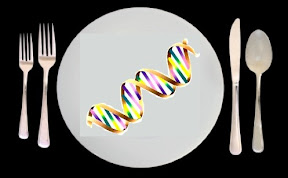The human genome has about 3 billion base pairs, making up around 20000 genes, which then make op our 24 chromosomes. The base pairs are made up of four nucleotides, represented by the letters A, C, G, & T. So how do we accurately obtain the sequence of 3 billion of these letters? The method used today is called the termination method, and will be explained below.
First, chromosomes are cut into lengths around 150000 base pairs long, using a restriction enzyme. These enzymes cut the DNA whenever they encounter a specific sequence of letters. Next, the DNA fragments are separated from each other and are introduced to DNA vectors, in order to make clones. DNA vectors are DNA strand of known sequence, which form into a circle. The circles are split open chemically, and allow the human DNA fragment to insert, see illustration. To clone these vectors, bacteria are introduced. When the bacteria takes a vector into its cell, the vector will be duplicated when the bacteria duplicates. These bacteria are then cultured until millions of copies of one DNA fragment are obtained!
Now the sequencing process can begin. Heat is added to separate the double strand DNA into single strand. Then, three materials are added to the copies of the DNA fragment & vector. First, a primer is added, which has a sequence matching the end of the vector strand, so the beginning of the human DNA can be found. A mixture of regular nucleotides, A, C, T & G is added, and new double strands begin to form onto the separated single strands. This process would go on until the whole human DNA fragment is duplicated, but special terminator nucleotides are added to the mixture to stop the process at random points.
Since the ratio of regular to terminator nucleotides is very high, duplicated strands will be anywhere from 2 base pairs long to hundreds of base pairs long before a terminator happens to stop the process.
Now we have millions of DNA strands of varying length, with special terminator nucleotides on the end of each one. These terminators are extra special because each one of the four has the ability to reflect light when a laser is shown on it! The colors reflected can be seen in the illustration just above.
 |
| Illustrations courtesy of pbs.org: NOVA online |
This process of sequencing is repeated for all of the cut chromosome fragments and different vectors until the entire sequence is obtained!



No comments:
Post a Comment